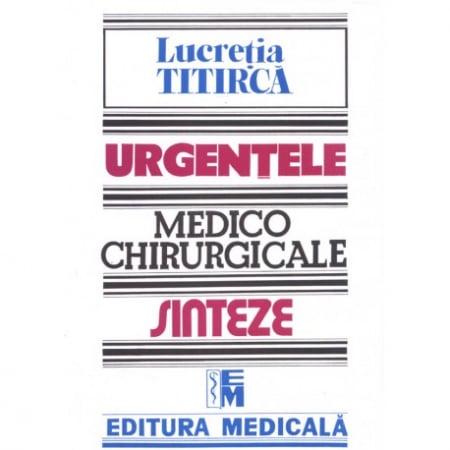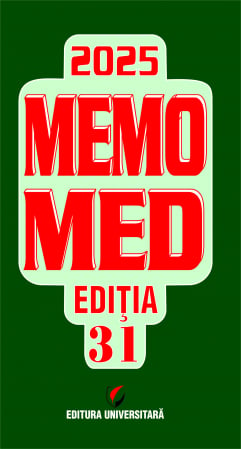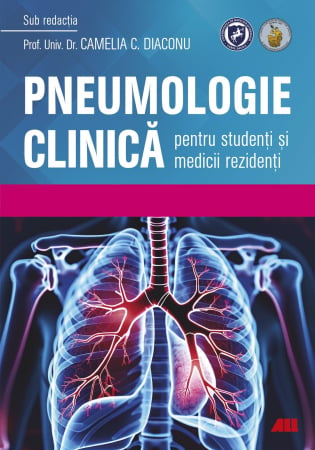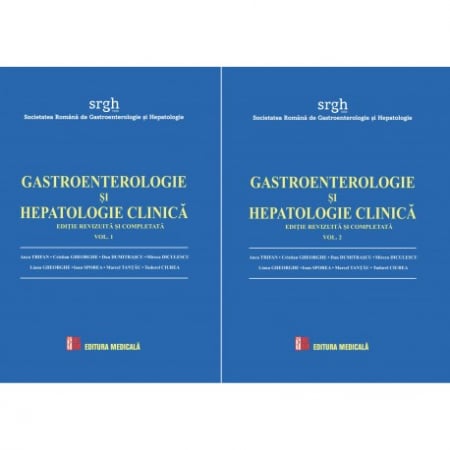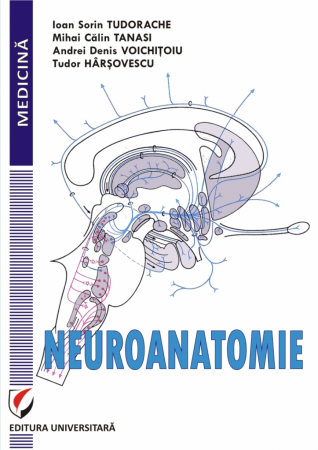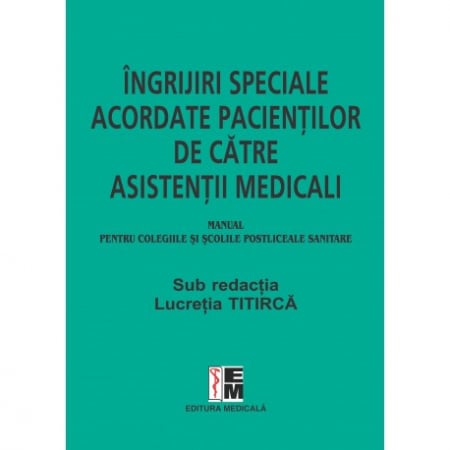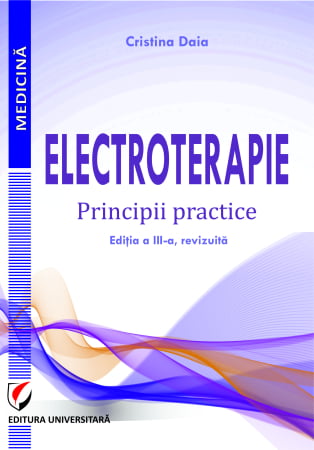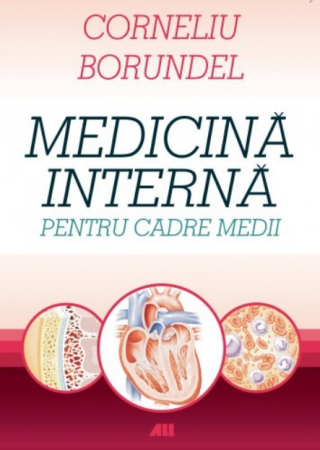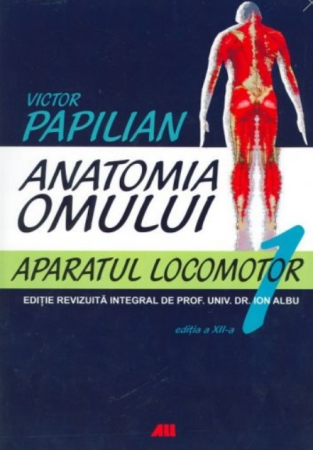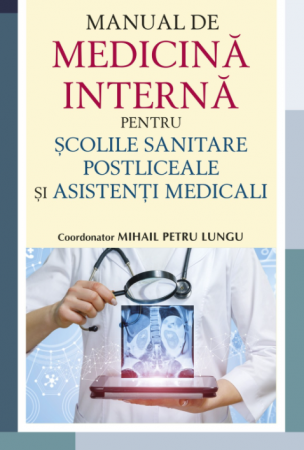Manuscript proposals: [email protected] / 0745 204 115 //// Tracking orders Individuals / Sales: 0745 200 357 / Orders Legal entities: 0721 722 783
ISBN: 978-606-28-1325-3
DOI: https://doi.org/10.5682/9786062813253
Publisher year: 2021
Edition: I
Pages: 368
Publisher: Editura Universitară
Author: Simona Trifu, Ana Miruna Dragoi
Product Code:
9786062813253
Do you need help?
0745 200 357
- Description
- Download (1)
- Authors
- Content
- More details
- Reviews (0)
The book "Clinical Interferences in Psychiatry. Diagnostic Experiences” is intended to be a collection of clinical presentations, namely a number of 38 examples grouped according to major diagnostic categories. Thus, the perspective is approached on anxiety, major depression, suicide risk, obsessive-compulsive disorder, bipolar affective disorder, acute and transient or polymorphic psychotic disorders, schizophrenia in its various forms, delusional disorder and broad spectrum of personality disorders. This book is the fifth work of this kind by Simona Trifu, bringing together a richer collection and a wider diagnostic palette, succeeding, at the same time, in a more careful and rigorous structuring of practical knowledge, out of the desire to transmit valid models to future generations. of expression in psychiatric clinic terminology.
-
Clinical interference in psychiatry. Diagnostic experience
Download
Coordinator
SIMONA TRIFU
ANA MIRUNA DRAGOI
SIMONA TRIFU
ANA MIRUNA DRAGOI
Preface / 11
Generalized anxiety disorder - present condition after remission
Present condition without psychopathological changes at the time of examination - evaluation model - Simona Trifu / 18
Major depressive episode - psychiatric and cognitive behavioral perspective
Cumulative Trauma in Recurrent Depressive Disorder - Antonia Ioana Vasile / 22
Major depressive episode with psychotic phenomena - psychiatric and psychodynamic presentation
Major depressive episode with psychotic phenomena developed late postpartum - Ana Miruna Dragoi, Alia Ionuta, Doina Bordeianu (Ioana) / 47
Major depressive episode with psychotic phenomena - psychiatric and psychodynamic presentation
Diagnostic dilemma: acute psychotic episode versus major depressive episode with psychotic phenomena - Simona Trifu, Alexandra Popescu, Eduard George Carp / 56
Suicide - psychiatric and psychodynamic perspective
Suicide attempt "Suicide is an act of courage ... but my courage ..." - Simona Trifu / 64
Suicide - psychiatric presentation
Suicide attempt and twilight condition - Alexandra Popescu / 78
Obsessive compulsive disorder - psychiatric and psychodynamic presentation
The Suffering of Obsessive Compulsive Disorder with High Criticism or “Lucid Madness” by Pierre Janet - Simona Trifu, Violeta Bratu, Anton Istrate, Bogdan Baceanu / 86
Obsessive compulsive disorder - psychiatric and psychodynamic presentation
Obsessive-compulsive disorder with high functioning - Bianca Valeria Constantin, Roxana Andreea Mihordea / 95
Obsessive compulsive disorder - psychiatric and psychodynamic presentation
Obsessive-compulsive disorder and drug use - Maria Ilie, Clara Tudose, Alexandra Tudor / 103
Bipolar affective disorder - approach to clinical psychology
Bipolar affective disorder - implications on functioning in remission - Ana Miruna Dragoi / 118
Bipolar affective disorder - synthesis of diagnostic commission opinions
Bipolar affective disorder. Severe expansive episode with psychotic phenomena and psychomotor agitation, with the particularity of the favorable response to Clozapine - Ana Miruna Dragoi / 121
Bipolar affective disorder - analysis of speech and behavior during the interview (diagnostic commission); duration of the interview: one hour
Impairment of social functioning in bipolar affective disorder superimposed on a paranoid structure - Simona Trifu / 124
Acute psychotic disorders - psychodynamic perspective
Acute and transient psychotic decompensations in a cluster personality A. Stress model analysis - diathesis - Simona Trifu, Elena Tiron, Andreea Ilie / 134
Acute psychotic disorder - synthesis of diagnostic commission opinions
Acute reaction to a stress factor in Mixed personality disorder with acute and transient psychotic decompensations in the background - Simona Trifu / 144
Acute psychotic disorder - forensic perspective
Forensic implications in twilight conditions superimposed on acute psychotic episodes - Ana Miruna Dragoi, Bianca Kohn, Marian Onofreiu / 148
Schizophrenia with predominance of thought disorganization - psychodynamic perspective, evaluation of clinical psychology, psychopharmacological objectives
Chaos and intra-psychic deficit in the intra-psychic foundations of formal and content disorders in schizophrenia - Simona Trifu / 164
Paranoid schizophrenia in complete remission for ten years under medication - presentation of clinical psychology
Paranoid schizophrenia with quality remission. The issue of interdiction. The need for forensic re-evaluation - Alexandra Geara / 174
Paranoid schizophrenia - evaluation of clinical psychology
Treatment-resistant schizophrenia - Ana Miruna Dragoi / 182
Schizophrenia - analysis of speech and behavior during the interview (diagnostic commission); duration of the interview: one hour
Inhibition and nonsense in paranoid schizophrenia, Florida episode - Simona Trifu / 184
Schizophrenia - psychiatric perspective, clinical psychology and psychodynamics
The perspective of cumulative and trans-generational traumas in an old paranoid schizophrenia - Letitia Anculete, Ioana Raluca Petru / 187
Schizophrenia - psychiatric and psychodynamic perspective
Cognitive disorganization in schizophrenia - Antonia Ioana Vasile / 205
Schizophrenia - psychiatric and psychodynamic perspective
Affectivization of a chronic paranoid schizophrenia after several years of disease evolution - Alexandra Stanica, Andreea Sisu, Iuliana Stoica / 212
Schizophrenia - psychiatric perspective
Paranoid schizophrenia with disorganization in thinking and multiple fragmentary delusional ideation, erotomaniac delirium and predominantly sexual themes - Anca Sevcenco, Monica Stanescu, Cristina Stavar, Andreea Luminita Maria Lazarovici, Alexandra Marcu, Violeta Florentina Mihai / 218
Schizophrenia - psychiatric and psychodynamic perspective
Paranoid schizophrenia with tendencies to affectification and histrionic features - Tiana Voicu, Elena Toma (Dumitru Popescu) / 228
Schizophrenia - psychiatric and psychodynamic perspective
The Secret of the Blue Whale. The ghost of the murder - Simona Trifu, Alexandra Popescu / 239
Schizophrenia - case presentation - psychiatric model
Paraphrenic schizophrenia - Alexandra Popescu / 254
Schizophrenia - psychiatric and psychodynamic perspective
Expressing schizophrenia in the positive, negative and disorganizing panel - Teodora Maria Nut, Cristina Sabina Gongiulea / 262
Bipolar affective disorder - synthesis of diagnostic commission opinions
Delusional somatic disorder with bizarre psychotic change in behavior - Ana Miruna Dragoi / 270
Delusional disorder - psychiatric and psychodynamic perspective
Acute psychotic disorder with schizophreniform symptoms. Evolution to Paranoid Schizophrenia or Persistent Delusional Disorder? - Daniela Georgiana Nistor, Diana Cristina Stana / 273
Personality disorder - presentation of clinical psychology and psychodynamic elements
Schizotypal vein with elements of dependence - Alina Calin / 282
Personality disorders - psychiatric clinical description
Pathology of abandonment and acrosage in a cluster personality B - Simona Trifu / 288
Personality disorder - forensic situation
Suicide attempt against the background of ethanolic dependence on a particular personality structure - Simona Trifu / 293
Personality disorder - forensic situation
Pervasive action and social implications in accentuated personality structures - Simona Trifu / 297
Personality disorder - forensic situation
Perverse nucleus or nucleus psychopathy - Ana Miruna Dragoi / 308
Organic personality disorder - psychiatric and psychodynamic perspective
Organic Personality Disorder versus Organic Delusional Disorder? - Simona Trifu / 316
Dependent. Clinical interpretive approach and through cognitive behavioral therapy
Depression, toxicophilic drives and addictive risk. Existential unhappiness approached from the perspective of CBT - Antonia Ioana Vasile, Daniela Ionescu / 330
The issue of gender identity - psychiatric and psychodynamic perspective
Identity issues in gender dysphoria - Laura Delcescu, Iris Savu, Andreea Turlui, Alexandra Elena Ungureanu, Bianca Georgiana Visan / 344
Dementia mixa. Synthetic somatic and psychiatric presentation
The need for rapid sedation in delirium tremens in a somatic patient - Simona Trifu, Alexandra Popescu, Ana Miruna Dragoi / 356
Bibliography / 361
Generalized anxiety disorder - present condition after remission
Present condition without psychopathological changes at the time of examination - evaluation model - Simona Trifu / 18
Major depressive episode - psychiatric and cognitive behavioral perspective
Cumulative Trauma in Recurrent Depressive Disorder - Antonia Ioana Vasile / 22
Major depressive episode with psychotic phenomena - psychiatric and psychodynamic presentation
Major depressive episode with psychotic phenomena developed late postpartum - Ana Miruna Dragoi, Alia Ionuta, Doina Bordeianu (Ioana) / 47
Major depressive episode with psychotic phenomena - psychiatric and psychodynamic presentation
Diagnostic dilemma: acute psychotic episode versus major depressive episode with psychotic phenomena - Simona Trifu, Alexandra Popescu, Eduard George Carp / 56
Suicide - psychiatric and psychodynamic perspective
Suicide attempt "Suicide is an act of courage ... but my courage ..." - Simona Trifu / 64
Suicide - psychiatric presentation
Suicide attempt and twilight condition - Alexandra Popescu / 78
Obsessive compulsive disorder - psychiatric and psychodynamic presentation
The Suffering of Obsessive Compulsive Disorder with High Criticism or “Lucid Madness” by Pierre Janet - Simona Trifu, Violeta Bratu, Anton Istrate, Bogdan Baceanu / 86
Obsessive compulsive disorder - psychiatric and psychodynamic presentation
Obsessive-compulsive disorder with high functioning - Bianca Valeria Constantin, Roxana Andreea Mihordea / 95
Obsessive compulsive disorder - psychiatric and psychodynamic presentation
Obsessive-compulsive disorder and drug use - Maria Ilie, Clara Tudose, Alexandra Tudor / 103
Bipolar affective disorder - approach to clinical psychology
Bipolar affective disorder - implications on functioning in remission - Ana Miruna Dragoi / 118
Bipolar affective disorder - synthesis of diagnostic commission opinions
Bipolar affective disorder. Severe expansive episode with psychotic phenomena and psychomotor agitation, with the particularity of the favorable response to Clozapine - Ana Miruna Dragoi / 121
Bipolar affective disorder - analysis of speech and behavior during the interview (diagnostic commission); duration of the interview: one hour
Impairment of social functioning in bipolar affective disorder superimposed on a paranoid structure - Simona Trifu / 124
Acute psychotic disorders - psychodynamic perspective
Acute and transient psychotic decompensations in a cluster personality A. Stress model analysis - diathesis - Simona Trifu, Elena Tiron, Andreea Ilie / 134
Acute psychotic disorder - synthesis of diagnostic commission opinions
Acute reaction to a stress factor in Mixed personality disorder with acute and transient psychotic decompensations in the background - Simona Trifu / 144
Acute psychotic disorder - forensic perspective
Forensic implications in twilight conditions superimposed on acute psychotic episodes - Ana Miruna Dragoi, Bianca Kohn, Marian Onofreiu / 148
Schizophrenia with predominance of thought disorganization - psychodynamic perspective, evaluation of clinical psychology, psychopharmacological objectives
Chaos and intra-psychic deficit in the intra-psychic foundations of formal and content disorders in schizophrenia - Simona Trifu / 164
Paranoid schizophrenia in complete remission for ten years under medication - presentation of clinical psychology
Paranoid schizophrenia with quality remission. The issue of interdiction. The need for forensic re-evaluation - Alexandra Geara / 174
Paranoid schizophrenia - evaluation of clinical psychology
Treatment-resistant schizophrenia - Ana Miruna Dragoi / 182
Schizophrenia - analysis of speech and behavior during the interview (diagnostic commission); duration of the interview: one hour
Inhibition and nonsense in paranoid schizophrenia, Florida episode - Simona Trifu / 184
Schizophrenia - psychiatric perspective, clinical psychology and psychodynamics
The perspective of cumulative and trans-generational traumas in an old paranoid schizophrenia - Letitia Anculete, Ioana Raluca Petru / 187
Schizophrenia - psychiatric and psychodynamic perspective
Cognitive disorganization in schizophrenia - Antonia Ioana Vasile / 205
Schizophrenia - psychiatric and psychodynamic perspective
Affectivization of a chronic paranoid schizophrenia after several years of disease evolution - Alexandra Stanica, Andreea Sisu, Iuliana Stoica / 212
Schizophrenia - psychiatric perspective
Paranoid schizophrenia with disorganization in thinking and multiple fragmentary delusional ideation, erotomaniac delirium and predominantly sexual themes - Anca Sevcenco, Monica Stanescu, Cristina Stavar, Andreea Luminita Maria Lazarovici, Alexandra Marcu, Violeta Florentina Mihai / 218
Schizophrenia - psychiatric and psychodynamic perspective
Paranoid schizophrenia with tendencies to affectification and histrionic features - Tiana Voicu, Elena Toma (Dumitru Popescu) / 228
Schizophrenia - psychiatric and psychodynamic perspective
The Secret of the Blue Whale. The ghost of the murder - Simona Trifu, Alexandra Popescu / 239
Schizophrenia - case presentation - psychiatric model
Paraphrenic schizophrenia - Alexandra Popescu / 254
Schizophrenia - psychiatric and psychodynamic perspective
Expressing schizophrenia in the positive, negative and disorganizing panel - Teodora Maria Nut, Cristina Sabina Gongiulea / 262
Bipolar affective disorder - synthesis of diagnostic commission opinions
Delusional somatic disorder with bizarre psychotic change in behavior - Ana Miruna Dragoi / 270
Delusional disorder - psychiatric and psychodynamic perspective
Acute psychotic disorder with schizophreniform symptoms. Evolution to Paranoid Schizophrenia or Persistent Delusional Disorder? - Daniela Georgiana Nistor, Diana Cristina Stana / 273
Personality disorder - presentation of clinical psychology and psychodynamic elements
Schizotypal vein with elements of dependence - Alina Calin / 282
Personality disorders - psychiatric clinical description
Pathology of abandonment and acrosage in a cluster personality B - Simona Trifu / 288
Personality disorder - forensic situation
Suicide attempt against the background of ethanolic dependence on a particular personality structure - Simona Trifu / 293
Personality disorder - forensic situation
Pervasive action and social implications in accentuated personality structures - Simona Trifu / 297
Personality disorder - forensic situation
Perverse nucleus or nucleus psychopathy - Ana Miruna Dragoi / 308
Organic personality disorder - psychiatric and psychodynamic perspective
Organic Personality Disorder versus Organic Delusional Disorder? - Simona Trifu / 316
Dependent. Clinical interpretive approach and through cognitive behavioral therapy
Depression, toxicophilic drives and addictive risk. Existential unhappiness approached from the perspective of CBT - Antonia Ioana Vasile, Daniela Ionescu / 330
The issue of gender identity - psychiatric and psychodynamic perspective
Identity issues in gender dysphoria - Laura Delcescu, Iris Savu, Andreea Turlui, Alexandra Elena Ungureanu, Bianca Georgiana Visan / 344
Dementia mixa. Synthetic somatic and psychiatric presentation
The need for rapid sedation in delirium tremens in a somatic patient - Simona Trifu, Alexandra Popescu, Ana Miruna Dragoi / 356
Bibliography / 361
The book "Clinical Interferences in Psychiatry. Diagnostic Experiences” is intended to be a collection of clinical presentations, namely a number of 38 examples grouped according to major diagnostic categories. Thus, the perspective is approached on anxiety, major depression, suicide risk, obsessive-compulsive disorder, bipolar affective disorder, acute and transient or polymorphic psychotic disorders, schizophrenia in its various forms, delusional disorder and broad spectrum of personality disorders. This book is the fifth work of this kind by Simona Trifu, bringing together a richer collection and a wider diagnostic palette, succeeding, at the same time, in a more careful and rigorous structuring of practical knowledge, out of the desire to transmit valid models to future generations. of expression in psychiatric clinic terminology.
Being up to date with Simona Trifu's editorial activity, we remember a previous work published in LAP publishing house, which follows the vein of antisocial personality and its way of reflecting in eight different nosographic areas. This book takes up the idea of clinical psychology, which identifies particular personality traits and personality structures, axis II diagnoses in the vision of DSM – IV – TR or DSM – 5 and refers to the ways in which they can be decompensated according to psychodynamic mechanisms. defense and can thus be expressed in the clinical record. Most clinical situations involved hospitalizations in psychiatric services, others - a small part - patients in remission, in clinical psychology offices, psychotherapy or in psychiatric monitoring that involves a long-term therapeutic alliance.
In the foreground, the authors focus on the psychiatric perspective of the cases. Thus, many of the examples contain extensive psychiatric examinations, with nuanced terminology used, with differentiating concepts and emphasizing their importance, which helps young psychiatrists, but also clinical psychologists, to go through a valid diagnostic tree, where the signs and symptoms of a disorder are reunited in clinical syndromes, which ultimately lead to a primary diagnostic assumption, with subsequent consideration of relevant differential diagnoses. They are presented: the diathesis of the still cause, the factors of positive prognosis, of negative prognosis, evolutionary perspectives, basic pharmacological principles, sometimes with details of the chosen therapeutic options and, finally, with highlights of the specific particularities.
Other cases represent diagnostic syntheses, opinions of specialized commissions, in which the importance is the explicit transcription of a patient's thinking with a certain diagnosis, pathognomonic cases to be presented to future generations, the authors highlighting the unconscious vein of a patient's intra-psychic dynamics. psychiatric, vein that leads, by virtue of experience and clinical feeling, to the main diagnosis. Other cases are richly explained in terms of clinical psychology, in the writing of this book being involved many clinical psychologists or younger psychotherapists, in various degrees of training in the field of psychiatry, as resident physicians, clinical psychologists or psychotherapists of various orientations. It is worth noting their enthusiasm, innovative thinking, modern perspectives, the way in which those concerned know how to mix cognitive-behavioral therapies with psychodynamics, experiential visions, particular models of ego reconstruction and psychiatric aspects, all under the coordination of Simona Trifu in a consistent time period, in which he guided the younger specialists, helping them to understand the relevant dynamics of the projective tests, the use of multiphase personality inventories, as well as the main clinical scales used in psychiatry.
The psychodynamic perspective, in which schizophrenia and, especially, the pathology and the problem of major depression and suicide are approached, is not to be neglected. Within each exposed diagnostic nosographic entity, they are grouped in a crescendo of pathological instinctual force, the peak reaching the multiple cases of schizophrenia cited, there is a continuum between the extreme of affective schizophrenia, going through forms of paraphrenic schizophrenia, productive schizophrenia (the richness and explicitness of a florid delirium) versus negative forms (where the formal and content disorders of communication are captured), up to a few cases in which young specialists are initiated in writing expressions referring to severe psychiatric patients, who end up in remission. Many of the cases were a "test stone", because they bring together a whole psychiatric and psychodiagnostic methodology necessary for the preliminary elaboration, for the patient to reach the attention of the commissions at the level of forensic services. Not to be neglected is the pedagogical perspective from which the authors structure the entire volume, the emphasis being on the transmission of knowledge and on the identification of certain fundamental concepts.
Presented at various congresses, the cases can constitute diagnostic clinical series, from which aspects of organicity are not omitted, as Freud himself spoke of the "biological rock". Students or young specialists, after reading this book, manage to acquire certain professional skills, in terms of identifying psychic phenomena in the area of semiology, the ability to differentiate the normal from pathological in mental life, which is so useful for specialists in office issues. , when those concerned need to select, combine, use knowledge and skills, so that they are able to in their minds, the speech of psychiatric patients to reflect in an organized manner in the diagnostic tree. Going through the material stimulates logical thinking, but also intuition and creativity, helping young specialists to differentiate between premorbid psychological profile and the development of psychiatric disorder, thus gaining autonomy in relation to the psychiatric patient, a patient who often scares both psychotherapists beginning of the road, as well as doctors of other specialties. They are taught to respect the ethical principles in force, good practices, the code of ethics.
The perpetual reference to the relevant professional training sources in the field, the punctuation of the meeting moment between psychiatry, clinical psychology, psychodynamics, experiential elements and cognitive-behavioral psychotherapy help the personal and professional development of the young generation, by acquiring and refining the ability to use countertransference. the diagnostic act. The authors focus on emphasizing the general assumptions, with examples in each presentation of the countertransference, the degree of anatomical-pathological damage, biochemical assumptions, as well as social and psychological ones belonging to the stress-diathesis model, hereditary-collateral antecedents. Psychosomatic vision should not be omitted, where appropriate, when psychosocial factors affect the medical condition. Depressive versus dysphoric emotional reactions are carefully differentiated.
Reference is made to the diagnostic stage: disease diagnosis, cross-sectional diagnosis, longitudinal diagnosis. The information is presented both at a deep level and at the level of classical psychiatry, the fact implying the understanding of the defenses at stake and the explanation of the unconscious level regarding the mechanisms of affective management. Trans-generational transmissions versus taking on role models in certain clinical situations are discussed. Examples of speech become the "key" to the neurotic, psychotic or borderline functioning of the patient, who is constantly exposed to the diagnosis. The prognosis of cure, the prognosis of recurrence, the prognosis regarding the affectation of the quality of life under treatment or under a certain form of psychotherapy is evaluated.
Regarding the presentations of schizophrenia, it calls for the development related to the territory of interpersonal relationships, to the older hypotheses of Beatson and Sullivan, which are directly related to a modern receptive pleiad and the ways of action of the latest generation psychopharmacology. , recent information talking about deficient syndrome (Carpenter) as a marker of prognosis. All these modern discoveries and researches are linked in a fine womb with the Freudian model of conflict or deficit, with the perspective of the amount of energy attached to any intra-psychic structure or object representations. The transference attachment behavior in the entire written diagnostic pleiad is analyzed and the correlation with the withdrawal of emotional investment at archaic stages of development.
In addition to presenting the DSM-IV-TR or DSM-5 criteria for various pathologies, there are elements of psychodynamics, which refer to early emotional deficiency, the anxious self, the prospect of exclusion from the world, the psychology of the ego and the deficient delimitation of borders, to hypersensitivity as a princeps trait of psychiatric patients, to terror as the axis of human interaction in schizophrenia.
In the case of presentations of depression, there are patterns of relational and drug intervention in suicide risk, and the mobilization of Simona Trifu as a doctor - to find with the patient the hidden causes of his moral pain - is obvious, providing support versus firmness in the relationship , the development of the self-esteem of these patients being the supreme desideratum. Depression is revealed both psychiatric, endogenous, receptive, biochemical, with reference to anatomical and functional, and through the prism of self-turned anger and the perfectionist image of an incomprehensible Supra-I: anaclitic depression, introjective depression, refusal of relationships interpersonal.
Regarding the perspective on anxiety, the connection between biological and genetic factors is shown, as well as the idea that neurobiological data explain the panic attack, not the psychological trigger that triggers it.
The book finally presents us with a plethora of psychiatrically destructed selves, from simple and "uncomplicated" selves, unable to live suffering in a space adjacent to the soul, to fragmented selves, dissolved selves, lost forms of self, which the specialists involved in writing this book have both the purpose and the moral obligation to help them become functional in thinking, to cancel their alexithymia and depression, to help them regain control, the ultimate goal of the authors being to present the effort from -a psychiatric clinic in rediscovering mental, emotional and somatic normalcy.
We confidently recommend the use of this manual, which is nothing more than an effort to organize the mind and soul of the young specialist, in order to increase the efficiency in terms of operationalizing his professional thinking, all exposures being directly imprinted by evidence based medicine concepts.
University professor doctor Cristian VASILE
Doctor of Medicine
President of the International Society for Applied Psychology
Being up to date with Simona Trifu's editorial activity, we remember a previous work published in LAP publishing house, which follows the vein of antisocial personality and its way of reflecting in eight different nosographic areas. This book takes up the idea of clinical psychology, which identifies particular personality traits and personality structures, axis II diagnoses in the vision of DSM – IV – TR or DSM – 5 and refers to the ways in which they can be decompensated according to psychodynamic mechanisms. defense and can thus be expressed in the clinical record. Most clinical situations involved hospitalizations in psychiatric services, others - a small part - patients in remission, in clinical psychology offices, psychotherapy or in psychiatric monitoring that involves a long-term therapeutic alliance.
In the foreground, the authors focus on the psychiatric perspective of the cases. Thus, many of the examples contain extensive psychiatric examinations, with nuanced terminology used, with differentiating concepts and emphasizing their importance, which helps young psychiatrists, but also clinical psychologists, to go through a valid diagnostic tree, where the signs and symptoms of a disorder are reunited in clinical syndromes, which ultimately lead to a primary diagnostic assumption, with subsequent consideration of relevant differential diagnoses. They are presented: the diathesis of the still cause, the factors of positive prognosis, of negative prognosis, evolutionary perspectives, basic pharmacological principles, sometimes with details of the chosen therapeutic options and, finally, with highlights of the specific particularities.
Other cases represent diagnostic syntheses, opinions of specialized commissions, in which the importance is the explicit transcription of a patient's thinking with a certain diagnosis, pathognomonic cases to be presented to future generations, the authors highlighting the unconscious vein of a patient's intra-psychic dynamics. psychiatric, vein that leads, by virtue of experience and clinical feeling, to the main diagnosis. Other cases are richly explained in terms of clinical psychology, in the writing of this book being involved many clinical psychologists or younger psychotherapists, in various degrees of training in the field of psychiatry, as resident physicians, clinical psychologists or psychotherapists of various orientations. It is worth noting their enthusiasm, innovative thinking, modern perspectives, the way in which those concerned know how to mix cognitive-behavioral therapies with psychodynamics, experiential visions, particular models of ego reconstruction and psychiatric aspects, all under the coordination of Simona Trifu in a consistent time period, in which he guided the younger specialists, helping them to understand the relevant dynamics of the projective tests, the use of multiphase personality inventories, as well as the main clinical scales used in psychiatry.
The psychodynamic perspective, in which schizophrenia and, especially, the pathology and the problem of major depression and suicide are approached, is not to be neglected. Within each exposed diagnostic nosographic entity, they are grouped in a crescendo of pathological instinctual force, the peak reaching the multiple cases of schizophrenia cited, there is a continuum between the extreme of affective schizophrenia, going through forms of paraphrenic schizophrenia, productive schizophrenia (the richness and explicitness of a florid delirium) versus negative forms (where the formal and content disorders of communication are captured), up to a few cases in which young specialists are initiated in writing expressions referring to severe psychiatric patients, who end up in remission. Many of the cases were a "test stone", because they bring together a whole psychiatric and psychodiagnostic methodology necessary for the preliminary elaboration, for the patient to reach the attention of the commissions at the level of forensic services. Not to be neglected is the pedagogical perspective from which the authors structure the entire volume, the emphasis being on the transmission of knowledge and on the identification of certain fundamental concepts.
Presented at various congresses, the cases can constitute diagnostic clinical series, from which aspects of organicity are not omitted, as Freud himself spoke of the "biological rock". Students or young specialists, after reading this book, manage to acquire certain professional skills, in terms of identifying psychic phenomena in the area of semiology, the ability to differentiate the normal from pathological in mental life, which is so useful for specialists in office issues. , when those concerned need to select, combine, use knowledge and skills, so that they are able to in their minds, the speech of psychiatric patients to reflect in an organized manner in the diagnostic tree. Going through the material stimulates logical thinking, but also intuition and creativity, helping young specialists to differentiate between premorbid psychological profile and the development of psychiatric disorder, thus gaining autonomy in relation to the psychiatric patient, a patient who often scares both psychotherapists beginning of the road, as well as doctors of other specialties. They are taught to respect the ethical principles in force, good practices, the code of ethics.
The perpetual reference to the relevant professional training sources in the field, the punctuation of the meeting moment between psychiatry, clinical psychology, psychodynamics, experiential elements and cognitive-behavioral psychotherapy help the personal and professional development of the young generation, by acquiring and refining the ability to use countertransference. the diagnostic act. The authors focus on emphasizing the general assumptions, with examples in each presentation of the countertransference, the degree of anatomical-pathological damage, biochemical assumptions, as well as social and psychological ones belonging to the stress-diathesis model, hereditary-collateral antecedents. Psychosomatic vision should not be omitted, where appropriate, when psychosocial factors affect the medical condition. Depressive versus dysphoric emotional reactions are carefully differentiated.
Reference is made to the diagnostic stage: disease diagnosis, cross-sectional diagnosis, longitudinal diagnosis. The information is presented both at a deep level and at the level of classical psychiatry, the fact implying the understanding of the defenses at stake and the explanation of the unconscious level regarding the mechanisms of affective management. Trans-generational transmissions versus taking on role models in certain clinical situations are discussed. Examples of speech become the "key" to the neurotic, psychotic or borderline functioning of the patient, who is constantly exposed to the diagnosis. The prognosis of cure, the prognosis of recurrence, the prognosis regarding the affectation of the quality of life under treatment or under a certain form of psychotherapy is evaluated.
Regarding the presentations of schizophrenia, it calls for the development related to the territory of interpersonal relationships, to the older hypotheses of Beatson and Sullivan, which are directly related to a modern receptive pleiad and the ways of action of the latest generation psychopharmacology. , recent information talking about deficient syndrome (Carpenter) as a marker of prognosis. All these modern discoveries and researches are linked in a fine womb with the Freudian model of conflict or deficit, with the perspective of the amount of energy attached to any intra-psychic structure or object representations. The transference attachment behavior in the entire written diagnostic pleiad is analyzed and the correlation with the withdrawal of emotional investment at archaic stages of development.
In addition to presenting the DSM-IV-TR or DSM-5 criteria for various pathologies, there are elements of psychodynamics, which refer to early emotional deficiency, the anxious self, the prospect of exclusion from the world, the psychology of the ego and the deficient delimitation of borders, to hypersensitivity as a princeps trait of psychiatric patients, to terror as the axis of human interaction in schizophrenia.
In the case of presentations of depression, there are patterns of relational and drug intervention in suicide risk, and the mobilization of Simona Trifu as a doctor - to find with the patient the hidden causes of his moral pain - is obvious, providing support versus firmness in the relationship , the development of the self-esteem of these patients being the supreme desideratum. Depression is revealed both psychiatric, endogenous, receptive, biochemical, with reference to anatomical and functional, and through the prism of self-turned anger and the perfectionist image of an incomprehensible Supra-I: anaclitic depression, introjective depression, refusal of relationships interpersonal.
Regarding the perspective on anxiety, the connection between biological and genetic factors is shown, as well as the idea that neurobiological data explain the panic attack, not the psychological trigger that triggers it.
The book finally presents us with a plethora of psychiatrically destructed selves, from simple and "uncomplicated" selves, unable to live suffering in a space adjacent to the soul, to fragmented selves, dissolved selves, lost forms of self, which the specialists involved in writing this book have both the purpose and the moral obligation to help them become functional in thinking, to cancel their alexithymia and depression, to help them regain control, the ultimate goal of the authors being to present the effort from -a psychiatric clinic in rediscovering mental, emotional and somatic normalcy.
We confidently recommend the use of this manual, which is nothing more than an effort to organize the mind and soul of the young specialist, in order to increase the efficiency in terms of operationalizing his professional thinking, all exposures being directly imprinted by evidence based medicine concepts.
University professor doctor Cristian VASILE
Doctor of Medicine
President of the International Society for Applied Psychology
If you want to express your opinion about this product you can add a review.
write a review

6359.png)
![Clinical interference in psychiatry. Diagnostic experience [1] Clinical interference in psychiatry. Diagnostic experience [1]](https://gomagcdn.ro/domains/editurauniversitara.ro/files/product/large/trifu-dragoi_interferente-clinice-in-psi-_bt-3201-8771.jpg)
